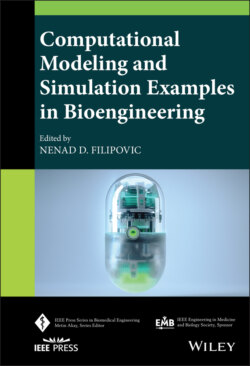Читать книгу Computational Modeling and Simulation Examples in Bioengineering - Группа авторов - Страница 23
1.7.3 Modeling the Deformation of Blood Vessels
ОглавлениеIn modeling blood flow in large blood vessels, we have recognized two distinct cases: (i) rigid walls and (ii) deformable walls. The assumption (i) is mostly adopted in practical applications. It is very important to determine the stress–strain state in tissue, when blood and blood vessel system is analyzed, as well as the effects of the wall deformation on the blood flow characteristics.
There are complex mechanical characteristics of blood vessel tissue. The tissue can be modeled from linear elastic to nonlinear viscoelastic model. The governing finite element equations used in modeling wall tissue deformation with emphasis on implementation of nonlinear constitutive models are summarized.
If the principle of virtual work is applied, the differential equations of motion of a finite element are
(1.7)
where the element matrices are: M is mass matrix; Bw is the damping matrix, in case when the material has a viscous resistance; K is the stiffness matrix; and Fext is the external nodal force vector which includes body and surface forces acting on the element. The dynamic differential equations of motion by the standard assembling procedure are obtained. These differential equations are integrated with a selected time step size Δt. The displacements n + 1U at end of time step are finally obtained according to equation:
(1.8)
where the tissue stiffness matrix and vector are expressed in terms of the matrices and vector in (1.7). Above equation is obtained under the assumption that the problem is linear: the viscous resistance is constant, displacements are small, and the material is linear elastic.
In many real examples as in case of aneurism or heart ventricle motion, the wall displacements can be large, hence the problem becomes geometrically nonlinear. Also, the tissue of blood vessels has nonlinear constitutive law which has to be expressed with materially nonlinear finite element formulation. Therefore, the linear formulation of the equation may not be appropriate. For a nonlinear problem, there is incremental–iterative equation
(1.9)
Here, ΔU(i) are the nodal displacement increments for the iteration “i,” and the system matrix , the force vector , and the vector of internal forces n + 1Fint(i − 1) correspond to the previous iteration.
We described the material nonlinearity of blood vessels which is used in further applications. The geometrically linear part of the stiffness matrix, , and nodal force vector, n + 1Fint(i − 1), are defined:
(1.10)
Here, the consistent tangent constitutive matrix of tissue and the stresses at the end of time step n + 1σ(i − 1) depend on the material model used.
